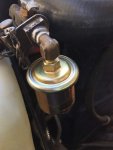I added an oil pressure gauge to my M1009 and plumbed it into a tee so I can still have a functioning low oil pressure warning light.
Things got a little kooky when I discovered the oil switch is threaded 1/8-27 npt and NOT the 1/4 npt I thought.
Turns out the 6.2 block actually has a 45 degree fitting threaded into the oil passage under the oil switch.
That fitting is 1/4 x 18 male thread where it goes into the block and 1/8 x 27 female thread where the oil pressure switch goes.
I bought a 1/4 x 18 brass tee and a 1/4 nipple.
Lucky for me the gauge came with a bushing that adapted it to fit the 1/4 x 18 tee.
A little re-work of my plan and I have an oil light and pressure gauge.
I know, it should match my volt meter in color.. I like the white gauges better.
View attachment 699845
Here is the crazy 45 degree fitting that was threaded into the block of my 6.2. Note; It is 1/4 - 18 male where it goes into block and 1/8 - 27 female where the warning light went.
This necessitated a re-work of how I planned to put things together but achieved the same result.
View attachment 699844
Here is how it ultimately went together.
That tool at the bottom is my well worn Basin wrench. You can find them in the plumbing aisle. Mine has 25 years of plumbing work on it but was just the tool to remove the stock oil pressure switch. That and some PB blaster.
View attachment 699846
Installed and working. Yes, I used teflon tape knowing full well that the switch uses the block connection to ground to illuminate the idiot light. Call me an idiot, but the pipe threads make more than enough contact slicing through the teflon tape to make contact.
View attachment 699847
CUCVRUS would never approve!
I know there is a slight difference in color between the oil pressure gauge and stock 28 volt gauge on the right.
Sue me.
(All in fun my friend.. still looking for those WYO plates for you)
I like white backed gauges.
All that was left was to tap into the dash light wires to light up the gauge.
Oh yea, make sure to test everything out by running the engine to check for leaks before you close up the dash.
I routed the oil line to the gauge around the big wire harness and through the speedometer cable grommet.
Wanted it to always be visible for inspection in case of leaks.
Things got a little kooky when I discovered the oil switch is threaded 1/8-27 npt and NOT the 1/4 npt I thought.
Turns out the 6.2 block actually has a 45 degree fitting threaded into the oil passage under the oil switch.
That fitting is 1/4 x 18 male thread where it goes into the block and 1/8 x 27 female thread where the oil pressure switch goes.
I bought a 1/4 x 18 brass tee and a 1/4 nipple.
Lucky for me the gauge came with a bushing that adapted it to fit the 1/4 x 18 tee.
A little re-work of my plan and I have an oil light and pressure gauge.
I know, it should match my volt meter in color.. I like the white gauges better.
View attachment 699845
Here is the crazy 45 degree fitting that was threaded into the block of my 6.2. Note; It is 1/4 - 18 male where it goes into block and 1/8 - 27 female where the warning light went.
This necessitated a re-work of how I planned to put things together but achieved the same result.
View attachment 699844
Here is how it ultimately went together.
That tool at the bottom is my well worn Basin wrench. You can find them in the plumbing aisle. Mine has 25 years of plumbing work on it but was just the tool to remove the stock oil pressure switch. That and some PB blaster.
View attachment 699846
Installed and working. Yes, I used teflon tape knowing full well that the switch uses the block connection to ground to illuminate the idiot light. Call me an idiot, but the pipe threads make more than enough contact slicing through the teflon tape to make contact.
View attachment 699847
CUCVRUS would never approve!
I know there is a slight difference in color between the oil pressure gauge and stock 28 volt gauge on the right.
Sue me.
(All in fun my friend.. still looking for those WYO plates for you)
I like white backed gauges.
All that was left was to tap into the dash light wires to light up the gauge.
Oh yea, make sure to test everything out by running the engine to check for leaks before you close up the dash.
I routed the oil line to the gauge around the big wire harness and through the speedometer cable grommet.
Wanted it to always be visible for inspection in case of leaks.


